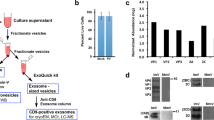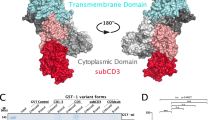Abstract
In eukaryotic cells, secretory proteins and glycoproteins migrate from the rough endoplasmic reticulum, their site of synthesis, through Golgi vesicles before being released from the cell1–9. Cellular and viral integral plasma membrane glycoproteins are co-translationally inserted into the rough endoplasmic reticulum membrane and follow a similar pathway to the cell surface2,3,10–15. Previous studies using endoglycosidase H (Endo H) suggested that in rat hepatoma cells the vesicular stomatitis virus (VSV) G protein, albumin and transferrin migrate from the rough endoplasmic reticulum to the Golgi apparatus at different rates16. Here we show directly that in human hepatoma HepG2 cells, five secreted proteins mature from the rough endoplasmic reticulum to Golgi vesicles at characteristic rates which differ at least threefold. The results are incompatible with bulk-phase movement of the luminal contents of the endoplasmic reticulum, and suggest that there is a membrane-bound receptor that selectively mediates the transport of secretory proteins from the rough endoplasmic reticulum to the Golgi.
This is a preview of subscription content, access via your institution
Access options
Subscribe to this journal
Receive 51 print issues and online access
$199.00 per year
only $3.90 per issue
Buy this article
- Purchase on Springer Link
- Instant access to full article PDF
Prices may be subject to local taxes which are calculated during checkout
Similar content being viewed by others
References
Palade, G. Science 109, 347–358 (1975).
Lodish, H. F., Braell, W., Schwartz, A., Strous, G. & Zilberstein, A. Int. Rev. Cytol. Suppl. 12, 241–307 (1981).
Sabatini, D. D., Kriebich, G., Morimoto, T. & Adesnik, M. J. Cell Biol. 92, 1–22 (1982).
Fahrquahr, M. G. & Palade, G. J. Cell Biol. 91, 77s–106s (1981).
Jamieson, J. D. & Palade, G. E. J. Cell Biol. 34, 577–596 (1967).
Jamieson, J. D. & Palade, G. E. J. Cell Biol. 34, 597–615 (1967).
Geuze, J.J., Slot, J. W. & Tokuyasu, K. T. J. Cell Biol. 82, 697–707 (1979).
Ravazzola, M., Perrelet, A., Roth, J. & Orci, L. Proc. natn. Acad. Sci. U.S.A. 78, 5661–5664 (1981).
Franz, C. P., Croze, E.M., Morre, J. & Schrieber, G. Biochim. biophys. Acta 678, 395–402 (1981).
Bergmann, J. E., Tokuyasu, K. T. & Singer, S. J. Proc. natn. Acad. Sci. U.S.A. 78, 1746–1750 (1981).
Croze, E. M. & Morre, D.J. Proc. natn. Acad. Sci. U.S.A. 78, 1547–1551 (1981).
Green, J., Griffiths, G., Louvard, D., Quinn, P. & Warren, G. J. molec. Biol. 152, 663–698 (1981).
Wehland, J., Willingham, M. C., Gallo, M. & Pastan, I. Cell 28, 831–841 (1982).
Scheele, G. Am. J. Physiol. 238, G467–G477 (1980).
Gumbiner, B. & Kelly, R. B. Cell 28, 51–59 (1982).
Stroud, G. J. A. M. & Lodish, H. F. Cell 22, 709–717 (1980).
Knowles, B. B., Howe, C. D. & Aden, D. P. Science 209, 497–499 (1980).
Patel, F. & Minta, J. D. J. Immun. 122, 1582–1586 (1979).
Ooi, Y. M. & Colton, H. R. J. Immun. 123, 2494–2498 (1979).
Kornfeld, R. & Kornfeld, S. in The Biochemistry of Glycoproteins and Proteoglycans (ed. Lennarz, W.J.) 1–34 (Plenum, New York, 1980).
Tarentino, A. L. & Maley, F. J. biol. Chem. 249, 811–816 (1974).
Tai, T., Yamashita, K. & Kobayta, A. Biochem. biophys. Res. Commun. 78, 434–441 (1977).
Robbins, P. W., Hubbard, S. C., Turco, S. J. & Wirth, D. F. Cell 12, 893–900 (1977).
Godelaine, D., Spiro, M.J. & Spiro, R. G. J. biol. Chem. 256, 10161–10168 (1981).
Rothman, J. E. Science 213, 1212–1219 (1981).
Tabas, I. & Kornfeld, S. J. biol. Chem. 254, 11655–11663 (1979).
Tulsiani, D. R. P., Hubbard, S. C., Robbins, P. W. & Touster, O. J. biol. Chem. 257, 3660–3668 (1982).
Rothman, J. E., Bursztyn-Pettegrew, H. & Fine, R. E. J. Cell Biol. 86, 162–171 (1980).
Fitting, T. & Kabat, D. J. biol. Chem. 257, 14011–14017 (1982).
Schwartz, A. L., Fridovich, S. & Lodish, H. F. J. biol. Chem. 257, 4230–4237 (1982).
Owen, M. J., Kissonerghis, A.-M. & Lodish, H. F. J. biol. Chem. 255, 9678–9684 (1980).
Zilberstein, A., Snider, M., Porter, M. & Lodish, H. F. Cell 21, 417–427 (1980).
Ledford, B. E. & Davis, D. F. J. biol. Chem. 258, 3304–3308 (1983).
Author information
Authors and Affiliations
Rights and permissions
About this article
Cite this article
Lodish, H., Kong, N., Snider, M. et al. Hepatoma secretory proteins migrate from rough endoplasmic reticulum to Golgi at characteristic rates. Nature 304, 80–83 (1983). https://doi.org/10.1038/304080a0
Received:
Accepted:
Published:
Issue Date:
DOI: https://doi.org/10.1038/304080a0
This article is cited by
-
Glycoprotein misfolding in the endoplasmic reticulum: identification of released oligosaccharides reveals a second ER-associated degradation pathway for Golgi-retrieved proteins
Cellular and Molecular Life Sciences (2013)
-
Cooverexpression of chaperones for enhanced secretion of a single-chain antibody fragment in Pichia pastoris
Applied Microbiology and Biotechnology (2007)
-
Monoclonal antibody refolding and assembly: Protein disulfide isomerase reaction kinetics
Biotechnology and Bioprocess Engineering (2003)
-
Giving protein traffic the green light
Nature Cell Biology (2000)
-
Monoclonal antibody refolding and assembly: Protein disulfide isomerase reaction kinetics
Biotechnology and Bioprocess Engineering (1996)
Comments
By submitting a comment you agree to abide by our Terms and Community Guidelines. If you find something abusive or that does not comply with our terms or guidelines please flag it as inappropriate.



